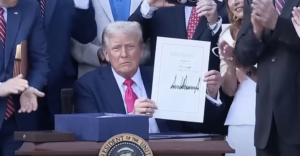
 Though the Walt Disney Co.'s healthy earnings helped its stock price to nearly double since 1995, a respected Wall Street financial publication claims the company has enhanced recent results by disregarding generally accepted accounting procedures.
Though the Walt Disney Co.'s healthy earnings helped its stock price to nearly double since 1995, a respected Wall Street financial publication claims the company has enhanced recent results by disregarding generally accepted accounting procedures.
Writing in Barron's, accounting professor Abraham Briloff of New York's Binghamton University, alleged that Disney created an unreported $2.5 billion reserve that inflated Disney's earnings after it took over the ABC television network in 1996.
Following Briloff's story in March, Barron's carried an update in May stating that Disney had also exaggerated its fiscal second-quarter results.
By selectively making certain adjustments in its year-to-year comparisons, Barron's reported most recently that Disney was able to report a $68 million profit, an increase of 21 percent over the previous year. But according to the May update in Barron's, an even-handed treatment of these comparisons would have resulted in second-quarter net earnings of just $2 million.
Briloff, a certified public accountant, focused on Disney accounting maneuvers related to the ABC merger in his March article in Barron's. His analysis: Disney devalued ABC's tangible assets by $700 million and increased the network's liabilities by $2.9 billion.
Briloff wrote that the move paid two dividends:
• While these accounting entries didn't entitle Disney to a current tax deduction, as those amounts later become tax-deductible business expenses the company will derive a $1.2 billion tax benefit.
• The adjustments created a "loss reserve" account estimated at $2.5 billion, which the company could use to pay post-merger expenses without affecting its bottom line.
Disney's former vice president of corporate controllership wouldn't reveal to Barron's the exact size of the loss reserve. In a letter responding to the analysis prior to publication, the company took issue with the use of the term "loss reserve," saying it followed generally accepted accounting principles (GAAP).
However, Briloff noted, Disney did not dispute the size of the reserve.
"In this author's view, Disney's booking of those $2.5 billion or so of additional liabilities related to the network's future programming commitments as part of accounting for the merger as a purchase was simply not permissible under GAAP," Briloff wrote.
While Disney has been able to mask the negative impact of the network acquisition the past two years, from here on the true picture will become clearer, Briloff wrote.
"Clearly, had Disney not been able to use its reserve to shield its bottom line from major chunks of costs related to its foray into television network ownership, its recent results would have had considerably less luster.
"Indeed, the 25 percent earnings surge Disney reported in fiscal '97 would have come to 10 percent, without benefit of the accounting device. And, far from an 18 percent earnings increase in the December quarter, net would have been flat."
The implication of these stories and other developments is that the company is hurting, said one of the leaders in the multi-denominational Disney boycott that includes the Southern Baptist Convention.
Donald Wildmon, president of the American Family Association, said recent appearances by Disney chairman Michael Eisner on 60 Minutes and NBC's Today Show demonstrate he is feeling the pinch, although an effective boycott may require three years of effort.
During Today, Eisner said a "splinter group" of Southern Baptists had sparked the Disney boycott. He also likened a 1996 SBC resolution on Jewish evangelism with Nazi Germany.
Said Wildmon, "I've been at this for twenty years and if it's not affecting you, you ignore it. Or, you attack the people who are boycotting you. He wouldn't have gone on 60 Minutes or said anything if it wasn't hurting.
"Image is the only thing they have; once it's lost, they can't get it back. That's why Eisner is panicking. For me, this confirms (the boycott) is working."
While the change wasn't widely noted, Wildmon said, another example of its effectiveness has been in how The Disney Channel is offered to cable television subscribers.
In the fall of 1996, the Hollywood Reporter said the number of subscribers had dropped from a high of 8 million at mid-year to 5 million, a decline of 37 percent.
But since then, many cable companies quit offering Disney as a premium channel and started including it as part of optional packages, Wildmon said. Now, many subscribers who choose a "second tier" of channels — above the basic package — automatically receive Disney's channel, he said.














